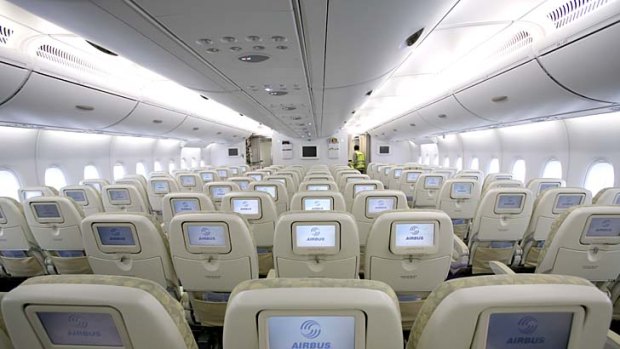By Oliver Smith

Take your pick ... some seats do have advantages over others in the event of a crash landing.Credit: AP
A look at the safest place to be seated if you're unlucky enough to be involved in a plane crash.
Although some claim that seats over the wing of an aircraft are best (because the plane is "strongest" there), popular opinion has it that, in the event of a plane crash, the rear of an aircraft is the safest place to be. This theory is supported by several studies, including a recent one featured on a Channel 4 documentary.
The producers of the documentary, The Crash, arranged for a Boeing 727 carrying cameras, sensors and crash test dummies with breakable "bones" to be deliberately crashed into the Sonoran Desert in Mexico.
After hitting the ground, the front of the plane and the first 11 rows of seats – usually reserved for first-class, business-class or premium-economy passengers – were ripped off. A force of 12G was recorded in this section of the aircraft. Further back, the force fell to around 6G. Experts concluded that none of the plane's first-class passengers would have survived, but 78 per cent of the other passengers would have, with the chance of survival increasing the closer they were sitting to the rear of the aircraft. According to a survey by sunshine.co.uk, the results of the study led to a sharp fall in the number of enquiries for first-class seats.
Though an analysis of a single crash is hardly decisive, its findings did support a study by Popular Mechanics, carried out in 2007. The magazine analysed all crashes since 1971 and found that those in rear seats (behind the wing's trailing edge) were safest – survival rates were 69 per cent as opposed to 56 per cent over the wing and 49 per cent for those at the front of the plane.
Despite such research, the world's two biggest aircraft manufacturers insist that no conclusive evidence is available.
"One seat is as safe as another," said a spokesman for Boeing. "Especially if you stay buckled up."
That is an important point. Last year's study in Mexico also saw three dummies placed in the same row, but in different positions: one in the brace position and wearing a seatbelt, one buckled up but sat normally, and one sat normally minus the belt. The unfastened traveller would have been the only one to perish, experts claimed. The most common cause of injury on an aircraft is when a plane is jolted by turbulence and passengers are wandering around the cabin, or not wearing a seatbelt. To avoid injuries from falling luggage or out-of-control dining carts, then surely a window seat is best?
Airbus said much the same as its rival, adding dryly that: "the safest aircraft is one that doesn't crash and is well maintained". Quite. It cited certification processes and evacuation testing – adding that the world's biggest aircraft, the A380, can be emptied of 850 passengers, in pitch darkness with half the doors closed, in under 90 seconds.
This evacuation issue is also key. Contrary to popular belief, the majority of plane crashes are survivable. One US government analysis of all 568 plane crashes in the US between 1993 and 2000, involving 53,487 passengers and crew, found that 51,207 – or over 90 per cent – survived. Even on the 26 crashes deemed the worst, more than half walked away. So surely a seat close to an exit would be safest? That theory is supported by a University of Greenwich study, commissioned by the CAA. Researchers checked the accounts of 2000 survivors in 105 accidents around the world. Those sat more than six rows from an exit were found to be far less likely to survive, though the difference between window and aisle seat was "marginal".
Conclusion
Flying is very safe. The odds of being killed on a single flight are 1 in 4.7 million, according to the website planecrashinfo.com.
But you might raise that figure slightly by sitting in economy class, with your seat belt fastened, by the window, within a few rows of an emergency exit.
- The Telegraph, London
Sign up for the Traveller newsletter
The latest travel news, tips and inspiration delivered to your inbox. Sign up now.